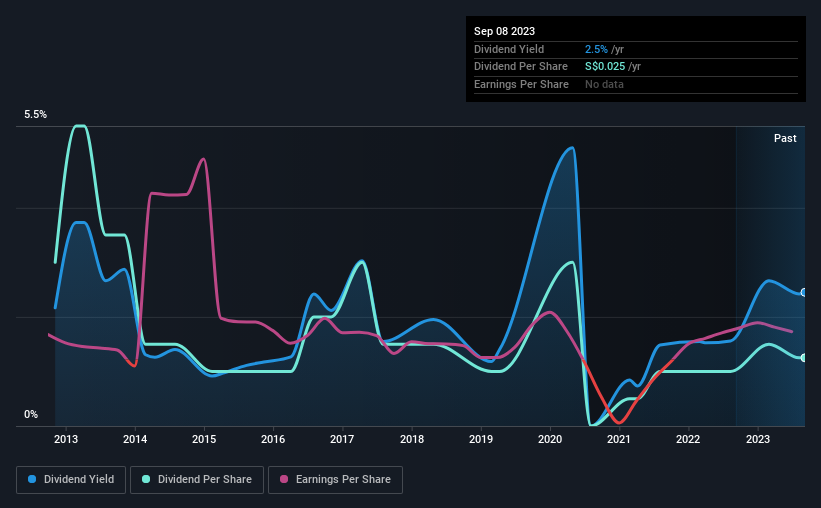Here's What We Like About OUE's (SGX:LJ3) Upcoming Dividend
Regular readers will know that we love our dividends at Simply Wall St, which is why it's exciting to see OUE Limited (SGX:LJ3) is about to trade ex-dividend in the next four days. The ex-dividend date is one business day before a company's record date, which is the date on which the company determines which shareholders are entitled to receive a dividend. The ex-dividend date is important as the process of settlement involves two full business days. So if you miss that date, you would not show up on the company's books on the record date. Accordingly, OUE investors that purchase the stock on or after the 13th of September will not receive the dividend, which will be paid on the 28th of September.
The company's next dividend payment will be S$0.01 per share, and in the last 12 months, the company paid a total of S$0.025 per share. Based on the last year's worth of payments, OUE has a trailing yield of 2.5% on the current stock price of SGD1.02. If you buy this business for its dividend, you should have an idea of whether OUE's dividend is reliable and sustainable. So we need to investigate whether OUE can afford its dividend, and if the dividend could grow.
See our latest analysis for OUE
Dividends are typically paid out of company income, so if a company pays out more than it earned, its dividend is usually at a higher risk of being cut. OUE is paying out just 15% of its profit after tax, which is comfortably low and leaves plenty of breathing room in the case of adverse events. Yet cash flows are even more important than profits for assessing a dividend, so we need to see if the company generated enough cash to pay its distribution. What's good is that dividends were well covered by free cash flow, with the company paying out 9.0% of its cash flow last year.
It's positive to see that OUE's dividend is covered by both profits and cash flow, since this is generally a sign that the dividend is sustainable, and a lower payout ratio usually suggests a greater margin of safety before the dividend gets cut.
Click here to see how much of its profit OUE paid out over the last 12 months.
Have Earnings And Dividends Been Growing?
Companies with consistently growing earnings per share generally make the best dividend stocks, as they usually find it easier to grow dividends per share. Investors love dividends, so if earnings fall and the dividend is reduced, expect a stock to be sold off heavily at the same time. This is why it's a relief to see OUE earnings per share are up 9.7% per annum over the last five years. Earnings per share have been growing at a decent rate, and the company is retaining more than three-quarters of its earnings in the business. This is an attractive combination, because when profits are reinvested effectively, growth can compound, with corresponding benefits for earnings and dividends in the future.
Another key way to measure a company's dividend prospects is by measuring its historical rate of dividend growth. OUE has seen its dividend decline 8.4% per annum on average over the past 10 years, which is not great to see. It's unusual to see earnings per share increasing at the same time as dividends per share have been in decline. We'd hope it's because the company is reinvesting heavily in its business, but it could also suggest business is lumpy.
Final Takeaway
Is OUE an attractive dividend stock, or better left on the shelf? Earnings per share have been growing moderately, and OUE is paying out less than half its earnings and cash flow as dividends, which is an attractive combination as it suggests the company is investing in growth. It might be nice to see earnings growing faster, but OUE is being conservative with its dividend payouts and could still perform reasonably over the long run. Overall we think this is an attractive combination and worthy of further research.
While it's tempting to invest in OUE for the dividends alone, you should always be mindful of the risks involved. To that end, you should learn about the 3 warning signs we've spotted with OUE (including 1 which is significant).
If you're in the market for strong dividend payers, we recommend checking our selection of top dividend stocks.
Have feedback on this article? Concerned about the content? Get in touch with us directly. Alternatively, email editorial-team (at) simplywallst.com.
This article by Simply Wall St is general in nature. We provide commentary based on historical data and analyst forecasts only using an unbiased methodology and our articles are not intended to be financial advice. It does not constitute a recommendation to buy or sell any stock, and does not take account of your objectives, or your financial situation. We aim to bring you long-term focused analysis driven by fundamental data. Note that our analysis may not factor in the latest price-sensitive company announcements or qualitative material. Simply Wall St has no position in any stocks mentioned.

 Yahoo Finance
Yahoo Finance 
